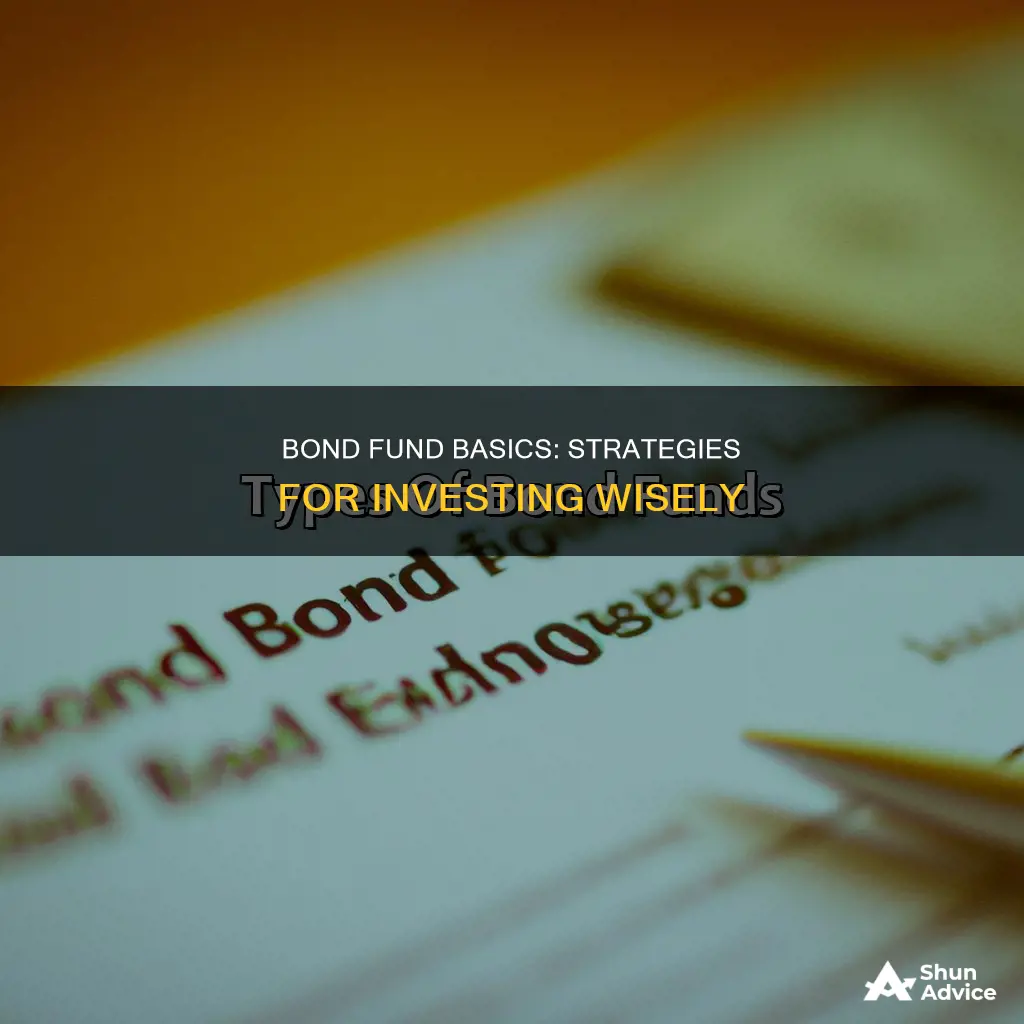
Investing in bonds is a great way to diversify your portfolio and reduce risk. Bonds are a form of lending money to a company or government rather than buying a stake, as you would with stocks. They are considered safer than stocks because they are less volatile and less sensitive to macroeconomic risks.
There are several types of bonds, including corporate, municipal, and treasury bonds. Corporate bonds are issued by companies to raise capital for initiatives like expansion and R&D. Municipal bonds are issued by local governments to raise money for public projects like schools and hospitals. Treasury bonds are issued by national governments and are considered the safest type of bond.
You can invest in bonds in several ways, including through a broker, an ETF, or directly from the government. When investing in bonds, it's important to consider the maturity date, the bond's rating, and your risk tolerance.
What You'll Learn

Bond funds vs individual bonds
Bond Funds vs. Individual Bonds
There are several factors to consider when deciding between investing in bond funds or individual bonds. These include diversification, convenience, costs, and control over maturity, described below.
Diversification
Bond funds offer greater diversification per dollar invested as they typically hold a large number of bonds with a variety of issuers, maturity dates, coupon rates, and credit ratings. This makes it easier to achieve a diversified bond portfolio, even with a small initial investment. On the other hand, individual bonds require a significant amount of bonds to achieve proper diversification, which may be cost-prohibitive for some investors.
Convenience
Bond funds are more convenient as they are managed by professionals, saving investors time and effort in researching and managing their bond portfolio. Bond funds also provide access to institutional pricing, which is typically better than what individual investors receive.
Costs
Bond funds usually come with management fees, which can be higher for actively traded funds and may lead to lower returns. In contrast, individual bonds typically have a commission charged when the bond is purchased, but there are no ongoing fees unless it is sold before maturity.
Control over Maturity
Individual bonds have a definite maturity date, while bond funds do not. Holding an individual bond to maturity guarantees the return of 100% of the principal, regardless of the interest rates at that time. Bond funds, on the other hand, do not have a defined maturity date, and there is no guarantee of recovering the principal at a specific time, especially in a rising-rate environment.
Other Considerations
The decision between bond funds and individual bonds depends on various factors, including the amount of money available for investment, financial goals, and behavioural preferences. Individual bonds offer greater control and transparency over the portfolio but require more time and financial resources. Bond funds, on the other hand, provide less control but are more tax-efficient and offer automatic dividend reinvestment.
Corporate Bond Funds: When to Invest for Maximum Returns
You may want to see also

Bond mutual funds
The primary goal of a bond mutual fund is to generate monthly income for investors. Most pay regular monthly income, although the amount may vary with market conditions. This feature can make bond funds an appropriate choice for investors who desire somewhat stable, regular income.
Like bonds, bond funds are generally a choice for the conservative investor. They are considered less risky than stocks and can help diversify your portfolio.
Mutual Fund Investment: Timing and Location Strategies
You may want to see also

Bond ETFs
There are several types of Bond ETFs, including short-, medium-, and long-term bond funds, as well as funds that focus on specific types of bonds, such as corporate or government bonds. When choosing a Bond ETF, it is important to consider the fund's diversification, credit quality, and maturity date. Diversification can be achieved by investing in a mix of bond types, geographic regions, and asset classes. Credit quality refers to the likelihood of the bond defaulting, with investment-grade bonds being less risky than below-investment-grade or "junk" bonds. The maturity date represents the date when the bond issuer will repay the principal amount, and this can vary from less than 5 years for short-term bonds to more than 10 years for long-term bonds.
Some examples of Bond ETFs include the Vanguard Total Bond Market ETF, which holds more than 8,300 domestic investment-grade bonds, and the Vanguard Total International Bond ETF, which invests in over 4,500 bonds from developed and emerging markets outside the US.
In summary, Bond ETFs offer a convenient and diversified way to invest in the bond market, providing exposure to a wide range of bonds and helping to reduce investment risk.
Bond Index Funds: When to Invest and Why
You may want to see also

Bond market vs brokers
Overview
The bond market is where investors go to trade debt securities, such as bonds, which may be issued by corporations or governments. Bonds can be bought from the bond market via a broker, through an ETF, or directly from the government.
Brokers
Brokers act as intermediaries between buyers and sellers of debt securities, keeping the identities of both parties anonymous. They execute over-the-counter (OTC) and listed bond trades on behalf of investors or traders and earn a commission for their services.
Brokers are necessary for purchasing certain types of bonds, such as municipal and corporate bonds. They trade bonds on the trading floor of an exchange or in the OTC markets.
Bonds can be bought through an online broker, or directly from the underwriting investment bank in an initial bond offering, which may provide a discount off the bond's face value.
Bond market
Bonds can also be bought directly from the government, without paying a fee to a broker or intermediary. This can be done through the Treasury Direct website for government bonds.
Bonds are mainly sold over the counter, rather than in a centralized location, and individual investors do not typically participate in the bond market. Instead, large institutional investors such as pension funds, foundations, and investment banks are involved.
Brokers are necessary for purchasing certain types of bonds and can provide expertise and anonymity. However, they may charge commissions and markups on bond prices, so investors must be vigilant and well-informed. The bond market allows direct access to bonds without these fees but typically involves large institutional investors.
Alternative Investment Funds: Diversifying Your Portfolio
You may want to see also

Bond types
There are three main types of bonds: corporate bonds, municipal bonds, and treasury bonds.
- Corporate bonds are debt securities issued by private and public corporations. They are typically used to finance operations or expansions. The risk and return on these bonds vary and usually depend on the issuing company's creditworthiness. Due diligence is essential before investing in corporate bonds.
- Municipal bonds, or munis, are debt securities issued by states, cities, counties, and other government entities to fund public projects or operations. They often provide steady interest cash flow for investors and offer tax advantages, as the interest earned is generally exempt from federal, state, and local taxes.
- Treasury bonds, or T-bonds, are long-term debt securities issued by the US Department of the Treasury on behalf of the US government. They are regarded as very safe investments, backed by the full faith and credit of the US government. Treasury bonds have maturities of 10, 20, or 30 years and offer lower yields than other types of bonds due to their low risk.
Other types of bonds include:
- International government bonds, or sovereign bonds, are issued by foreign governments and allow investors to diversify their portfolios geographically. However, they may carry additional risks, such as political instability and exchange rate volatility.
- Agency bonds are issued by government-sponsored enterprises or federal agencies. While not directly backed by the US government, they have a high degree of safety due to their government affiliation. These bonds typically have higher yields than Treasury bonds but may carry a call risk, meaning the issuer can repay the bond before the maturity date.
- Green bonds are debt securities issued to fund environmentally friendly projects, such as renewable energy or pollution reduction. They allow investors to support sustainability initiatives while earning interest.
- Zero-coupon bonds, or deep discount bonds, do not pay periodic interest. Instead, they are sold at a deep discount to their face value, and investors profit from the difference when the bond matures. Examples include US Treasury bills.
UK Index Funds: Where to Invest Your Money Wisely
You may want to see also
Frequently asked questions
Bond funds are mutual funds that invest in a range of bonds, such as corporate, municipal, treasury, or junk bonds. They usually pay higher interest rates than bank accounts and, for a low investment minimum, they allow you to invest in a diverse range of bonds, managed by professional money managers.
Bond funds usually include higher management fees and commissions. The income on a bond fund can fluctuate as they typically invest in multiple bond types. You may also be charged a redemption fee if you sell your shares within 60 to 90 days, and leveraged bond funds carry greater risk.
You can buy bond funds through an investment company, an online broker, or a financial advisor.
The type of bond funds you choose will depend on your risk tolerance, tax situation, time horizon, and income needs. It's recommended to include a mix of corporate, federal, and municipal bonds in your portfolio to reduce risk.







